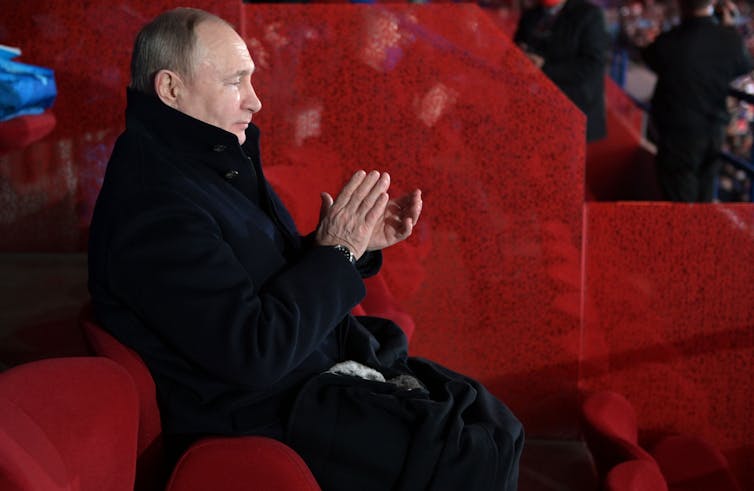
Alexei Druzhinin / Sputnik/AFP via Getty Images
Michael De Groot, Indiana University
As Russia masses forces and equipment on Ukraine’s border, international tensions over a possible invasion intensify almost daily. Ukraine has emerged as ground zero of what some pundits have dubbed a new Cold War between Russia and the West.
In my view as a Cold War historian, this comparison distorts the Cold War and misrepresents the stakes of the current crisis.
Yet reviewing the Cold War is important because its legacy shapes Russian President Vladimir Putin’s policy toward Ukraine.
While Ukraine was a Soviet republic during the Cold War, it has become the front line of a post-Cold War tug-of-war between Russia and the West. By insisting on NATO’s withdrawing its forces and weapons from former Soviet bloc countries, Putin would like to turn back the clock to the mid-1990s, before NATO expanded into Eastern Europe.
From my reading of public accounts, Putin views NATO as a relic that retains its Cold War purpose of containing Russia. In response to NATO expansion, Putin seeks to carve a buffer zone of his own, much as former Soviet leader Joseph Stalin did in response to American assistance in Europe after World War II, and consolidate a Russian sphere of influence in Eastern Europe.
What was the Cold War?
The Cold War was a global struggle of the United States and democratic capitalism against the Soviet Union and communism. It erupted in the mid-1940s after both nations emerged from World War II as superpowers and viewed each other as existential threats.
During World War II they had cooperated to defeat Nazi Germany and Japan. After the war, both agreed to occupy Germany jointly with Britain and France and wanted to continue the alliance once the fighting stopped.
But irreconcilable disagreements about the postwar international order rose to the surface.
The Soviet Union asserted control over Eastern Europe – the nations of Bulgaria, Czechoslovakia, Hungary, Poland and Romania – which the Soviet Army had liberated from the Nazis. Stalin supported local communists and intimidated their opponents, and the countries rarely held free elections. U.S. President Harry Truman’s administration accused Stalin of betraying an agreement at the wartime Yalta Conference to respect European democracy.
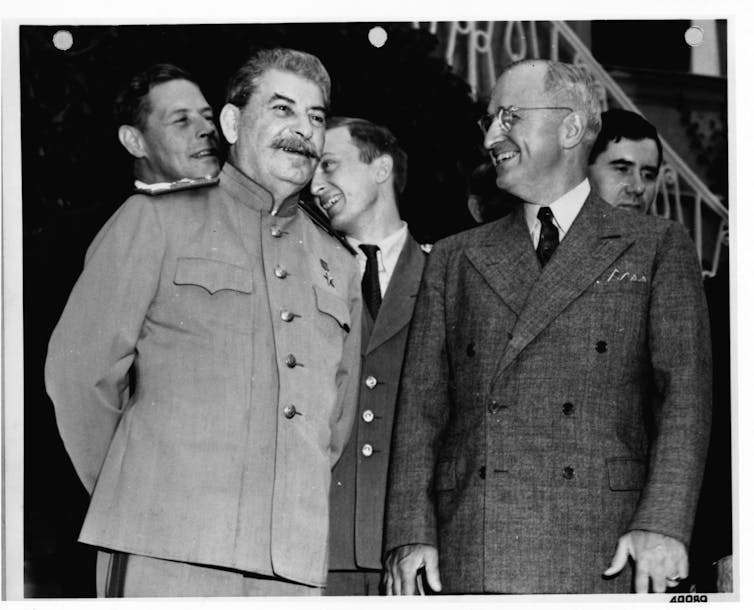
Library of Congress/Corbis/VCG via Getty Images
Yet what terrified U.S. officials most was the possibility that Soviet ideology would resonate with the Western European and German people who were struggling to recover from the war. U.S. policymakers feared that the desolate masses might elect communist governments that would ally with the Soviet Union against the United States.
Winning hearts and minds
In one of the turning points of the early Cold War, U.S. Secretary of State George C. Marshall announced an economic assistance initiative for Europe in June 1947. Congress authorized the program in April 1948. The Marshall Plan, as it became known, provided more than US$12 billion to aid European reconstruction during its three years of operation.
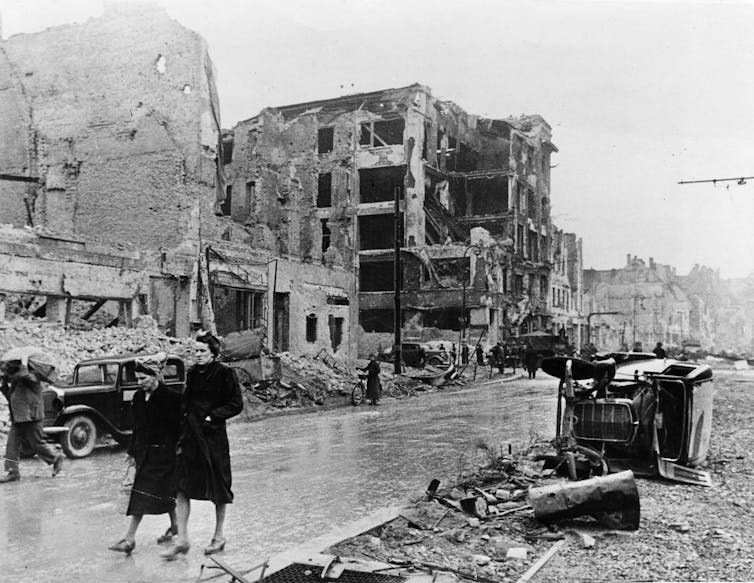
Sovfoto/Universal Images Group via Getty Images
But the Marshall Plan’s logic worried the Western Europeans. Fresh off two traumatic wars against a belligerent Germany, Western Europeans feared any effort to rebuild western Germany and place it on the path to statehood.
Breaking a long-standing tradition of avoiding entangling alliances, the United States joined the North Atlantic Treaty Organization in April 1949 to guarantee Western Europe’s security against West Germany, which became independent the following month.
Alarm bells flashed in Moscow. The Soviet Union had lost 27 million soldiers and civilians during the Second World War. And the United States wanted to rebuild postwar Germany.
In response, Stalin ordered the Eastern European communists to crack down on their domestic rivals. Moscow also created East Germany to counter West Germany. It now had a buffer zone of loyal communist countries to protect itself from the West.
The Cold War began in Europe, but it soon spread to Africa, Asia and Latin America. Each superpower feared that a setback in a developing country could give the other the advantage in the Cold War.
Although their forces did not square off directly, the United States and Soviet Union confronted each other through proxies in bloody conflicts such as the Korean and Vietnam wars.
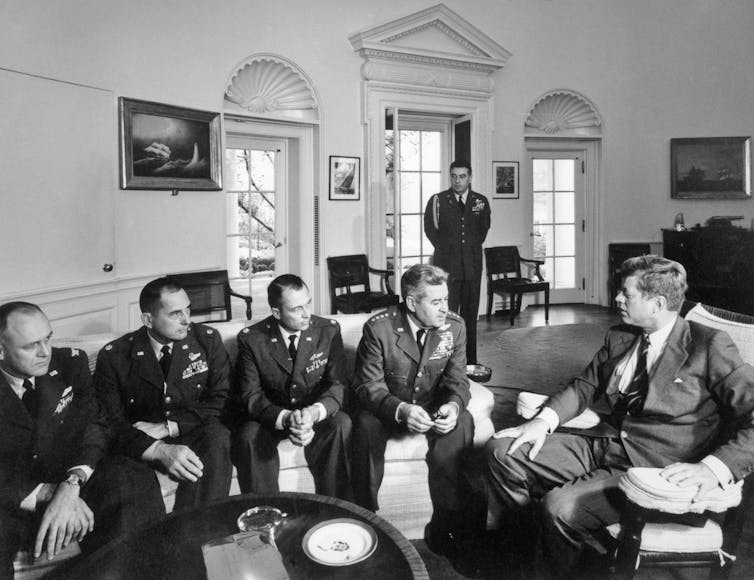
Charles Phelps Cushing/ClassicStock/Getty Images
The high stakes of the Cold War also brought the world close to nuclear annihilation. The Cuban Missile Crisis, for example, erupted in October 1962 when the Kennedy administration discovered that the Soviets had deployed missiles in communist Cuba. The United States and Soviet Union averted nuclear war after striking a bargain: The Kennedy administration promised never to invade Cuba and to withdraw American missiles in Turkey in exchange for the Soviet removal of the weapons from Cuba.
Soviet Ukraine
Ukraine joined Russia, Belarus and Transcaucasia, a federation consisting of Armenia, Azerbaijan and Georgia, as the Soviet Union’s founding republics in December 1922.
Ukraine suffered greatly under Stalin’s rule in the 1930s. A famine in the early 1930s, known as the Holodomor, killed close to 4 million Ukrainians. Today, many Ukrainians refer to the event as an act of genocide.
Thus, when the Nazis invaded the Soviet Union in June 1941, many Ukrainians initially welcomed them. The nationalist Stepan Bandera collaborated with the Nazis with the aim of establishing an independent Ukrainian state.
In a move whose significance contemporaries could not foresee, the presidium of the Supreme Soviet transferred Crimea from Russia to Ukraine in 1954. Crimea was important because the Soviet Union’s Black Sea Fleet had headquarters there.
The Soviet Union stationed one-third of its nuclear weapons on Ukrainian soil. When the Soviet Union collapsed in December 1991, Ukraine ranked as the third-largest nuclear state.
Ukraine transferred its nuclear weapons to Russia in the mid-1990s in exchange for Russian promises to respect Ukraine’s sovereignty. The United States and Britain were also parties to this agreement, known as the Budapest Memorandum.
After the fall of communism
The Cold War ended more than three decades ago, when West Germany and East Germany unified and communism collapsed across Eastern Europe and the Soviet Union.
NATO has since expanded to 14 countries that had been part of the Soviet bloc. This number includes three former Soviet republics: Estonia, Latvia and Lithuania, all of which border Russia.
NATO declared at its 2008 Bucharest Summit that Ukraine and Georgia, also former Soviet republics, also would become members sometime in the future.
Where NATO has expanded, membership in the European Union has usually come as well.
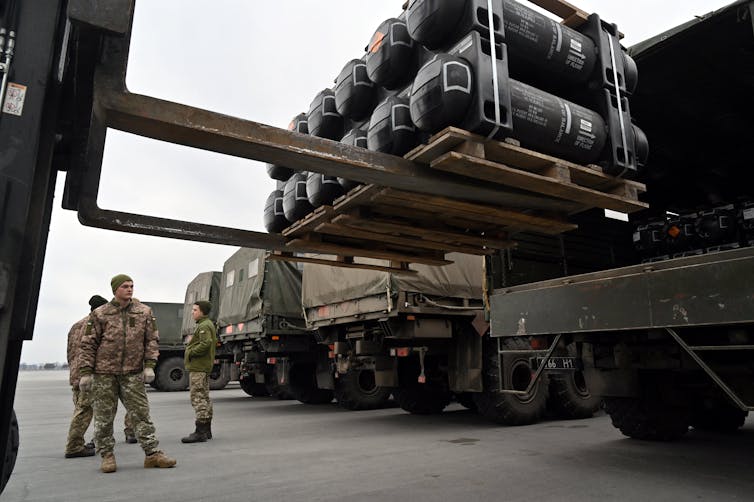
Sergei Supinsky/ AFP via Getty Images)
In my view, Putin fears Ukraine’s joining NATO and becoming a springboard for the United States to destabilize his regime. It is also my view that Putin believes Washington already uses the current Ukrainian government as a proxy for American interests.
The Russians annexed Crimea in March 2014, reversing what they claimed was a historical injustice. They have supported Ukrainian separatists in the eastern part of the country, which is known as the Donbass. These moves help prevent Ukraine from joining NATO because countries are not permitted to join the alliance if they have unresolved territorial disputes.
Putin’s fears are not without basis. The momentum of a democratic, prosperous and secure Ukraine could spill over into Russia and empower domestic challenges to Putin’s hold on power.
By precipitating a crisis over Ukraine, Putin wants to make sure that never happens.
[More than 150,000 readers get one of The Conversation’s informative newsletters. Join the list today.]![]()
Michael De Groot, Assistant Professor, International Studies, Indiana University
This article is republished from The Conversation under a Creative Commons license. Read the original article.
















